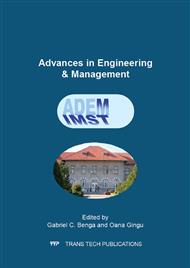[1]
**: http: /www. alueurope. eu/wp-content/uploads/2012/01/AAM-Products-1-Rolled-products. pdf, Accessed: 2014-09-08.
Google Scholar
[2]
C. Leppin, D. Daniel, R. Shahani, H. Gese, H. Dell, Formability Prediction Of Aluminum Sheet In Automotive Applications, AIP Conference Proceedings, 908 (2007) 117-122.
DOI: 10.1063/1.2740798
Google Scholar
[3]
R. Prillhofer, G. Rank, J. Berneder, H. Antrekowitsch, P. J. Uggowitzer, S. Pogatscher Property criteria for automotive Al-Mg-Si sheet alloys, Mater. 7 (2014) 5047-5068.
DOI: 10.3390/ma7075047
Google Scholar
[4]
J. Hirsch, T. Al-Samman, Superior light metals by texture engineering: Optimized aluminum and magnesium alloys for automotive applications, Acta Mater. 61 (2013) 818–843.
DOI: 10.1016/j.actamat.2012.10.044
Google Scholar
[5]
A. Ofenheimer, B. Buchmayr, R. Kolleck, M. Merklein, Forming limits in sheet metal forming for non-proportional loading conditions – experimental and theoretical approach, Numisheet 2005, Volume A, edited by L. M. Smith, F. Pourboghrat, J. W. Yoon, T. B. Stoughton, American Institute of Physics (2005).
DOI: 10.1063/1.2011263
Google Scholar
[6]
A. Lamik, H. Leitner, W. Eichlseder, F. A. Riemelmoser, Study of the fatigue behaviour of an aluminium-clad steel material compound, Strain 44 (2008) 440–445.
DOI: 10.1111/j.1475-1305.2007.00390.x
Google Scholar
[7]
M. C. Butuc, J.J. Gracio, A. Barata da Rocha, An experimental and theoretical analysis on the application of stress-based forming limit criterion, Int. J Mech. Sci. 48 (2006) 414–429.
DOI: 10.1016/j.ijmecsci.2005.11.007
Google Scholar
[8]
N. Tardif, S. Kyriakides, Determination of anisotropy and material hardening for aluminum sheet metal, Int. J Solids Struct. 49 (2012) 3496–3506.
DOI: 10.1016/j.ijsolstr.2012.01.011
Google Scholar
[9]
A. Güner, C. Soyarslan, A. Brosius, A. E. Tekkaya, Characterization of anisotropy of sheet metals employing inhomogeneous strain fields for Yld2000-2D yield function, Int. J Solids Struct. 49 (2012) 3517–3527.
DOI: 10.1016/j.ijsolstr.2012.05.001
Google Scholar
[10]
O. Engler, J. Hirsch, Texture control by thermomechanical processing of AA6xxx Al–Mg–Si sheet alloys for automotive applications-a review, Mater. Sci. Eng. A 336 (2002) 249–262.
DOI: 10.1016/s0921-5093(01)01968-2
Google Scholar
[11]
P. Castany, F. Diologent, A. Rossoll, J. F. Despois, C. Bezençon, A. Mortensen, Influence of quench rate and microstructure on bendability of AA6016 aluminium alloys, Mater. Sci. Eng. A 559 (2013) 558-565.
DOI: 10.1016/j.msea.2012.08.141
Google Scholar
[12]
S. Kurukuri, A. H. van den Boogaard, M. Ghosh, A. Miroux, Thermo-mechanical forming of Al–Mg–Si alloys: modeling and experiments, Proceedings of the 10th International Conferecne NUMIFORM 2010, edited by F. Barlat, Y. H. Moon, M.G. Lee, American Institute of Physics, (2010).
DOI: 10.1063/1.3457638
Google Scholar
[13]
S. Thuillier, E. Maire, M. T. Brunet, Ductile damage in aluminium alloy thin sheets: Correlation between micro-tomography observations and mechanical modeling, Mater. Sci. Eng. A 558 (2012) 217–225.
DOI: 10.1016/j.msea.2012.07.116
Google Scholar
[14]
F. Popa, I. Chicinaș{TTP}537 , D. Frunză, I. Nicodim, D. Banabic, Influence of high deformation on the microstructure of low-carbon steel, Int. Min. Metall. Mater. 21 (2014) 273-278.
DOI: 10.1007/s12613-014-0905-x
Google Scholar
[15]
O. Engler, Y. An, Correlation of texture and plastic anisotropy in the Al-Mg alloy AA 5005, Solid State Phenom. 105 (2005) 277 – 284.
DOI: 10.4028/www.scientific.net/ssp.105.277
Google Scholar
[16]
T. Clausmeyer, T. van den Boogaard, M. Noman, G. Gershteyn, M. Schaper, B. Svendsen, S. Bargmann, Phenomenological modeling of anisotropy induced by evolution of the dislocation structure on the macroscopic and microscopic scale, Int. J Mater. Form 4 (2011).
DOI: 10.1007/s12289-010-1017-4
Google Scholar


